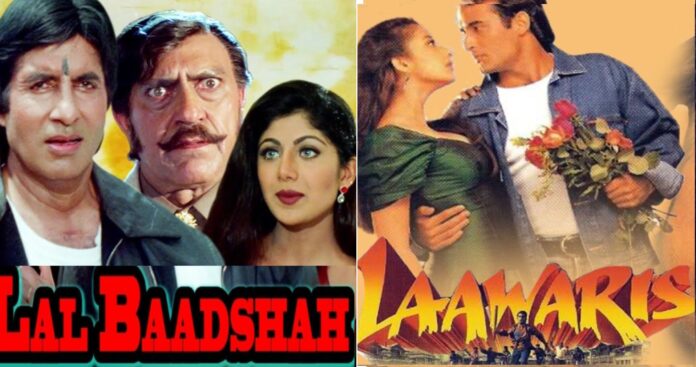LAL BAADSHAH
BMB Productions’ Lal Baadshah (A) is the story of a do-gooder who is a virtual one-man army. Inhabitants of a small town are terrified by the local don who is abetted in his criminal activities by his brother (a corrupt police officer) and father. But Lal Baadshah comes to their rescue time and again and vows to finish the don and his family. In their various confrontations, Lal Baadshah keeps scoring over the villains till finally, one day, he comes in their clutches. It is then revealed to the audience that the don’s father had an axe to grind with Lal Baadshah’s father who is presumed dead but is actually alive. The father and son ultimately join forces to eliminate the family of villains.
The story is as routine as routine can be but there is a good dose of action to keep the masses happy. The script is loose and shabbily written. For instance: the don’s activities are never shown and he is established as a don only through dialogues; the don’s father becomes the sworn enemy of Lal Baadshah’s father because he wants to lay his hands on the king’s treasure, but nothing is spoken of the treasure or its whereabouts thereafter! The romantic portion is weak and emotions are fair. Dialogues sound good at many places because of Amitabh Bachchan’s style of speaking. The second half is routine and tends to bore.
Amitabh Bachchan does a reasonably good job as Lal Baadshah. His romantic encounters with the heroine look funny because of the age difference between him and her. His Bhojpuri dialect will go down well with the audience in U.P. and Bihar mainly. In the role of the old father, he is average. The father’s wig looks funny. Manisha Koirala is ordinary and spoils the couple of comedy scenes she has, because of her mechanical performance. Her role is small and she remains out of the scene for long intervals. Shilpa Shetty is okay. Amrish Puri is effective. Raghuvaran makes an average don. Mukesh Rishi, as his brother, is fairly good. Nirupa Roy is so-so. Radhika does well in a brief role. Shakti Kapoor lends comic relief and should have had a better role. Prem Chopra gets very limited scope. Pramod Moutho and Mahesh Anand fill the bill. Naghma has been wasted in a song-dance.
Direction is aimed at satisfying the masses. Of the songs, ‘Dhanno ki aankh’ is very good. A couple of other songs are okay but the ‘Mera munna’ number is dull. Camerawork is quite appealing. Action scenes are well composed. Production values are alright.
On the whole, Lal Baadshah has an impressive initial value and masala for ‘B’ and ‘C’ class centres but does not have the power to sustain and go for a long run. An average fare, it will do well in U.P., Bihar and Rajasthan because of the Bhojpuri dialect of the hero and the action.
Released on 5-3-’99 at Dreamland, New Excelsior and 19 other cinemas of Bombay thru V.I.P. Enterprises. Publicity: very good. Opening: below the mark. …….Also released all over. Opening was mindblowing in U.P. (released on 2nd March), West Bengal, Bihar, C.P. Berar, C.I. and Rajasthan (1st day Jaipur: an astounding 2,74,000/- from 5 cinemas!).
LAAWARIS
Lama Productions’ Laawaris (UA) is a masala film with a routine story. It is about an orphan picked up by a don and groomed to become a law-breaker. He terrorises people of the basti in which he lives and tries the same with a lawyer and his wife who shift into the basti with their little kid. Although the lawyer’s practice isn’t going great guns, he is a man of principles and refuses to surrender to the arm-twisting tactics of the orphan boy and his gang. He even has altercations and fights with the boy. Gradually, the orphan begins to like the lawyer and his family. He also falls in love with a girl who happens to be the lawyer’s assistant and also the niece of the corrupt police commissioner. While the lawyer’s wife helps the orphan come closer to his beloved, the lawyer himself can’t forgive the orphan and becomes instrumental in breaking the relationship between him and his beloved. Soon thereafter, the orphan’s girlfriend, in frustration, agrees to get married to the don’s good-for-nothing son. But the orphan tries to win her back and by this time, he even has the lawyer on his side. The climax involves getting the two lovers together while eliminating the don and his huge gang. It abounds in action.
The story is very run-of-the-mill but the only redeeming factor is that writer Honey Irani’s characterisations are likeable as well as believable. However, the screenplay is replete with oft-repeated situations which are, therefore, predictable at every stage. Kamlesh Pandey’s dialogues are excellent at quite a few places. But all said and done, the audience’s thirst for novelty remains totally unquenched.
Akshaye Khanna acts freely and is endearing in light scenes. But he could have done better in dramatic scenes. Manisha Koirala looks disinterested in her work and delivers her dialogues as if she were a super-fast train! Jackie Shroff gives a restrained performance as the principled lawyer. He looks too fat, though. Dimple Kapadia comes up with an absolutely brilliant show and is as natural as natural can be. Govind Namdeo does an able job. Pramod Moutho is fair. Anita Kanwal, as his wife, shines. The scene in which she threatens to kill Pramod Moutho is clapworthy but it should have had more dialogues. Raza Murad, Parmeet Sethi, Johny Lever (not very hilarious) and Dinesh Hingoo lend good support. Rajesh Joshi, Jeetu Arora, Sanjeeva, Yogee, Milind Inamdar, Ankush Mohit and the rest are adequate.
Shrikant Sharma’s direction is fairly good but he has not been able to give anything new to the audience, nor has he made the drama exciting. Even the romantic portion is dull. Music (Rajesh Roshan) is very good. But the absence of a hit number is sorely felt. ‘Aa kahin door’ and ‘Maine kya kaha’ are well-tuned songs. Action scenes (Raam Shetty) are wonderfully composed. Camerawork is alright. Editing should have been much more smooth. Production and other technical values are of standard.
On the whole, Laawaris is a dull fare because it has no novelty and no excitement in the drama. Since it has opened to poor houses (almost all over India), it will entail heavy losses to its distributors in spite of having abundant action in the second half.
Released on 5-3-’99 at Alankar, Metro (matinee) and 15 other cinemas of Bombay thru B.R.A. Corporation. Publicity: excellent. Opening: average. …….Also released all over. Opening was pretty weak almost everywhere.
LATEST POSITION
The Holi holiday on 2nd March proved bountiful for the box-office. The examination period, however, has begun to adversely affect collections at the ticket-windows.
Kaun has been totally rejected everywhere except in Bombay and some parts of Maharashtra only. 1st week Bombay 27,59,654 (82.08%) from 6 cinemas (4 on F.H.); Ahmedabad 6,10,470 from 6 cinemas, Rajkot (matinee) 14,550, Jamnagar 44,415 (1 in matinee unrecd.); Solapur 1,25,828 from 2 cinemas (1 in matinee); Delhi 19,14,999 (52.62%) from 5 cinemas; Kanpur 1,08,802, Lucknow 1,17,639, Varanasi 70,125; Calcutta 3,91,931 from 3 cinemas (discontinued from a few cinemas after 3-4 days due to dismal attendance); Nagpur 2,43,268, Amravati 97,994; Indore 1,44,835 (3 on F.H.), Bhopal 1,13,368 from 2 cinemas; Jaipur 1,61,198 from 1 cinema (discontinued from 2nd cinema after 2 days due to extremely poor collections); Hyderabad (gross) 6,33,686 from 4 cinemas (1 in Hindi and 3 in Telugu); Davangere 1,23,167.
…………
Kachche Dhaage has dropped, but is still on the better side. 2nd week Bombay 38,42,747 (65.55%) from 13 cinemas (9 on F.H.); Ahmedabad 5,31,113 from 5 cinemas, 1st week Visnagar 1,25,500, 2nd week Padra 1,35,299, Rajkot 93,237, Jamnagar 1,26,582 from 2 cinemas (1 in matinee), Bhuj 79,367, Patan 1,17,812, total 3,07,390; Solapur 1,08,736; 1st week Bijapur 1,73,315; 2nd week Delhi 37,27,547 from 11 cinemas (2 on F.H.); Kanpur 2,52,205 (1 unrecd.), Lucknow 2,70,464, Varanasi 1,73,598, Bareilly (6 days) 1,34,857 (55.46%), Hardwar 56,682; Calcutta 10,26,455 from 10 cinemas; Nagpur 4,92,591 from 3 cinemas, Jabalpur 2,12,079, Amravati (6 days) 1,33,599, Akola 1,10,041, total 3,10,944, Raipur (6 days) 1,06,701, Bhilai (6 days) 69,734, Durg (6 days) 56,231, Jalgaon (6 days) 1,13,492 (1st 1,91,673), 1st Yavatmal 1,09,992; 2nd week Bhopal 1,13,232; Jaipur 5,24,886, Ajmer 1,39,133, Bikaner (gross) 1,72,914; Hyderabad (gross) 7,01,126 from 3 cinemas; Mangalore 1,03,985.
Daag The Fire 3rd week Bombay 5,76,355 (49.69%) from 3 cinemas (4 on F.H.); Ahmedabad 2,23,426 from 3 cinemas, Rajkot 94,022; Solapur 78,658; Delhi 6,37,663 from 4 cinemas (1 on F.H.); Kanpur 2,60,153 from 2 cinemas, Lucknow 2,76,166, Varanasi 64,914, Bareilly 85,340 (31.06%), Hardwar 80,000; Calcutta 4,23,316 from 7 cinemas; Nagpur 88,459 from 2 cinemas, Jabalpur 81,921, total 3,92,308, Amravati 1,22,780, Akola 1,06,190, total 3,99,090, share 3,05,500, Raipur 63,355, Bhilai 49,292, Jalgaon 81,856, total 4,22,661, Chandrapur 75,304, total 3,69,908, Yavatmal 47,194; Indore 1,82,102 from 2 cinemas, Bhopal 1,13,312; Jaipur 2,32,645, Bikaner 55,935; Hyderabad (gross) 5,37,569; Davangere 76,349.
Aa Ab Laut Chalen 6th week Bombay 5,76,158 (47.98%) from 2 cinemas; Ahmedabad 1,56,680 from 2 cinemas, 1st week Cambay 70,519, 6th week Rajkot (mg. shows) 21,477, Jamnagar (noon) 17,396; Solapur (matinee) 9,190; Delhi (TF) 3,86,730 from 2 cinemas (2 on F.H.); Kanpur 32,000, Lucknow 1,00,092, Varanasi 59,835, Hardwar 23,000, Muzaffarnagar 30,000, total 1,40,000; Calcutta 1,41,735; 5th week Jabalpur (TF) 37,649, total 3,46,767, 6th week Amravati 47,166, 2nd week Akola 56,000, 6th week Raipur (TF) 76,448, total 5,74,163, 4th week Chandrapur 68,098, total 3,78,417; 6th week Indore (TF) 91,470, 4th Bhopal (TF) 1,08,000; 6th week Hyderabad (gross) 2,73,643; 1st week Bellary 83,849.
Hum Aapke Dil Mein Rehte Hain 6th week Bombay 24,28,474 (60.28%) from 9 cinemas (5 on F.H.); Ahmedabad 3,96,367 from 3 cinemas, Baroda 1,39,214 (5th 1,13,952), Rajkot 1,12,961 from 2 cinemas (1 in matinee), Jamnagar 46,548; Solapur (14 shows) 1,05,107; Delhi 6,03,662 from 5 cinemas; Kanpur 1,59,402 from 2 cinemas, Lucknow 2,21,698, Varanasi 94,000, Bareilly 24,498 (9.43%); Calcutta 4,12,528 from 4 cinemas; Nagpur 1,31,316 from 2 cinemas, Jabalpur 41,891, total 5,60,820, Amravati 86,451, Akola 47,897, total 5,91,465, Raipur 65,041, Bhilai 56,909, 4th week Jalgaon 80,000, 6th Chandrapur 67,008, total 6,55,488; Jaipur 2,46,534 from 2 cinemas; Hyderabad (gross) 3,10,596.
Fire (dubbed, revived) 1st week Bombay 20,77,431 (62%) from 6 cinemas (8 on F.H.); Delhi 11,15,322 from 5 cinemas; Nagpur 56,790.
JAGMOHAN PASSES AWAY
Music director Jagmohan Bakshi (of Sapan-Jagmohan music director duo) passed away on 26th February in Bombay following a cardiac arrest. He was 69 and is survived by his wife, son and two daughters. The last rites were performed on 28th after his son’s arrival from abroad.
Jagmohan (like Sapan) was humble, polite and a simple person who never sought any publicity for his work.
Not many may be aware that Jagmohan started his career in 1951 as a playback singer with Navketan’s Taxi Driver under the baton of late S.D. Burman. He gave his voice to a song, Dekho maane nahi roothi hai haseena, which was picturised on Dev Anand.
In 1954, he formed a team with Sapan Sengupta and the duo scored music for as many as 90 films — 56 Hindi, 18 Punjabi and 16 Bengali. Their first assignment as music directors was a Punjabi film, Jijaji, which had super-hit songs. Their first Hindi film was Begana. One of its songs, Phir woh bhuli si yaad aayi hai, rendered by Mohd. Rafi, is still remembered. The duo’s other notable films were Chetna, Do Raha, Call Girl, Sajjo Rani, Mera Jivan and Darwaza.
Of late, Sapan Jagmohan were occupied with providing music for Hindi TV serials.
FILM INDUSTRY WITHDRAWS CALL TO BOYCOTT FILM CITY
The Federation of Western India Cine Employees, Film Makers Combine and Association of Motion Picture & TV Programme Producers have decided to revoke their call to boycott Film City. The decision to withdraw the boycott was taken on 4th March following a meeting of film industry representatives with Maharashtra minister for cultural affairs, Pramod Navalkar, and joint commissioner of police, Bombay, Dr. P.S. Pasricha. During the meeting, both, Navalkar and Pasricha, assured full protection to all film units and members of the film industry at Film City. Later on 4th March, the FWICE, FMC and AMPTPP unanimously decided at a joint meeting that only FWICE will be recognised by the film industry and no other group of workers would be granted recognition.
Earlier, on 26th February, FWICE, FMC and AMPTPP had issued a joint call to boycott Film City with immediate effect. The decision was taken soon after some Bharatiya Kamgar Sena activists stormed the sets of Dreamz & Filmz Pvt. Ltd. and disrupted the set-construction activity there. The BKS activists had taken this course following the producers’ refusal to meet their demand to employ their workers in the set construction. They (BKS activists) even got physical with the producers’ workers and the latter too retaliated. In the exchange of blows and fisticuffs, at least 3 BKS activists were injured badly and had to be hospitalised. The police arrested members of both the groups.
YOU ASKED IT
What must be the number of audio cassettes of Kuch Kuch Hota Hai that’ve been sold so far?
– Sony Music has so far sold more than 53 lakh units of the film.
Why has the Gujarat sub-territory suddenly become so cold?
– Artificially high prices of films for the sub-territory have led to heavy losses for the sub-distributors. The sub-circuit was, therefore, bound to become cold.
Why do star prices and film prices not come down to more realistic levels?
– Because of insecurity and greed of artistes and producers.
DO YOU KNOW?
* Amitabh Bachchan performed a daring stunt recently for Mehul Kumar’s KOHRAM despite the director and action director (Bhiku Verma) insisting that he use the services of a duplicate. Riding down the steps of Mount Mary’s church at Bandra, Bombay, atop a heavy motorcycle, Amitabh had to next cling on to a moving truck on its underside.
* LAL BAADSHAH has created a pink city record by collecting 2,74,000/- on the opening day (5 cinemas; 5 shows in 4 cinemas, and 6 shows in 1 cinema) in Jaipur. One show was held at Paras cinema on Thursday night without publicity and that was full. …In Jodhpur, the film collected 98,000/- on the first day at Nasrani cinema.
3-E
Education-Entertainment-Enlightenment
Kuch Kuch Naya Hai
The teaser trailer of Boney Kapoor’s Sirf Tum as well as the trailer (which is now on air on satellite channels) have been conceptualised by Karan Johar. The teaser trailer did not have the film’s title. Nor did it show any faces; it just showed two hands meeting, and a caption to the effect: ‘Can you ever fall in love with a person whom you’ve never met?’ The caption captures the essence of the film because…….. saying anything more would be giving out the film’s story. So we leave it at that.
Unusual Does The Trick?
The unusual invariably does the trick. Like it has done in the case of Guddu Dhanoa’s new film, titled Bichhoo. The unusual film title has drawn distributors’ attention to the film for which deals have been finalised for almost all the territories. Incidentally, Sudesh Gupta, manager of Subhash Ghai’s Mukta Arts, happened to see the logo of Bichhoo. He swears, it is imaginative and fantastic. The logo has been designed by Valles Publicity.
“A film’s climax shouldn’t look like a climax, it should be the culmination of the entire drama.”
– SUBHASH GHAI
The entire floor of Filmistan Studios has been converted into a studio of a huge entertainment company. The studio is very futuristic in its look, what with a dancing floor, a cafetaria on top, an office etc. etc. The eye-catching set is the brainchild of art director Sharmishta Roy and the film for which it has been constructed is Subhash Ghai’s Taal. Ghai is shooting a music piece on the set, involving plenty of dancers and musicians, and choreographing the same is young Ahmed Khan.
Subhash Ghai, after hours of rehearsals, sets the camera and discusses the shot with his cameraman, Kabir Lall. Since it is an elaborate shot, requiring the use of a crane and trolley, the exact timing of the camera movements is of paramount importance. Once the detailing of the camera movements is taken over by Kabir, Ghai goes to the area where the musicians are seated and gets the seating arrangements reorganised. All this, while Ahmed Khan is making the dancers rehearse and perfect their steps.
The scene requires, besides the dancers and the musicians, Anil Kapoor, Aishwarya Rai, Alok Nath, Mita Vashisth and Saurabh Shukla to participate. Anil is the rich studio owner, and the scene shows his team rehearsing for a show. Aishwarya and her father, who’ve come to Bombay from a small-time town, have been called that day by Anil Kapoor for a possible job offer (for Aishwarya). Mita Vashisth is Aishwarya’s aunt who is negotiating the deal. Saurabh Shukla plays Anil’s secretary.
Aishwarya and her father have never seen anything like this studio ever before and quite understandably so. They stare wide-eyed and even while they are waiting to be called by Anil, they see him oversee the rehearsal and just walk away from there into his chamber on the mezzanine floor without so much as even acknowledging their presence. This perplexes them and they wonder why he did not talk to them as he himself had asked them to see him. His secretary puts them at ease and tells them that his boss has four eyes, two in the front and two behind, and that his eyes at the back of his head had seen Aishwarya and the others waiting and that he would therefore call them. Sure enough, just then, Anil Kapoor calls out to the three waiting for him.
There are several takes before the shot is okayed. In between shots, Subhash Ghai reveals a part of the story and says, he is very pleased with the climax he has shot. Climax shot? “Yes,” informs Ghai, “I have already shot the difficult climax.” Explaining why he had shot the climax first, much before a major part of the film, he says, “Very often, climax, when shot last, looks very different from the rest of the film. This time, therefore, I decided to shoot the climax much in advance so that the portions before the climax can be shot in relation thereto. The idea is that the climax shouldn’t look like a climax but should be the culmination of the entire drama. Once the climax is shot, I can make sure that the earlier part of the film is going in the right direction.” Elaborating further about the climax shooting, Ghai says, “Anil fell ill while shooting it — he was so tense because it was a difficult climax for him and he obviously wanted to give his best.” Subhash is more than happy with Anil’s performance in the climax. In fact, Ghai is totally sold on Anil’s sincerity and jokes, “I wonder what Anil’s old age will be like, the guy is so hyper.”
Was the poor fate of Akshaye Khanna (the other hero of Taal) starrers disturbing Ghai? “I’m not disturbed, but the responsibility on my shoulders has increased. Akshaye is a good actor and he deserves a hit. I hope, he gets it fast because otherwise, the best of actors can be shattered.”
Talking of his scripting, the filmmaker reveals how he had not been able to control his tears when he was writing one particular emotional scene between Aishwarya and Alok Nath. “The tears just welled up in my eyes and came right on the paper on which I was writing the scene.” How had the scene, which had made him cry while writing it, shaped out to be on celluloid? “Oh, fantastic,” says Ghai contentedly.
Taal is being readied for release in August. Considering that the entire talkie portion will be complete after the current schedule which will stretch till mid-April, the release date should not be difficult to meet. After the ongoing shooting spell, only a song and a rain sequence will remain to be picturised. Talking of songs brings one to the film’s music director, A.R. Rahman. Just the music piece being shot then gives an idea of how brilliant the songs of the film must be. The effort that has gone into preparing and recording the songs is too much. And not just because A.R. Rahman had preferred to record the songs of Taal only in the nights. Maybe, that is when he had his sur and taal the rightest!
– Komal Nahta




























